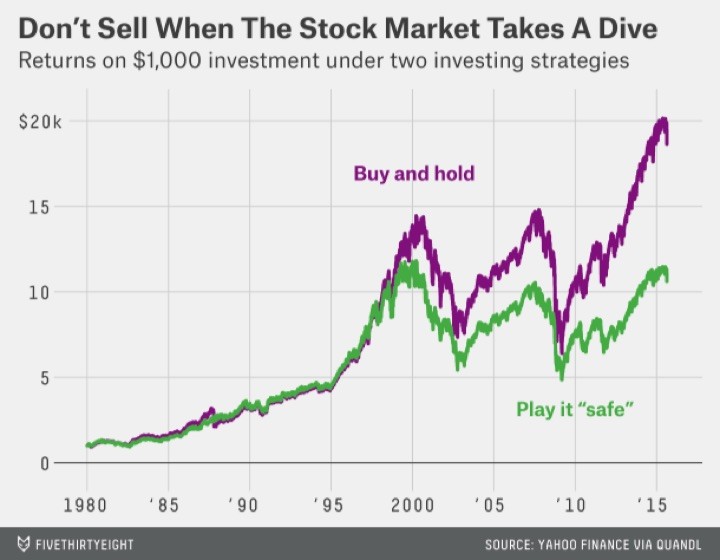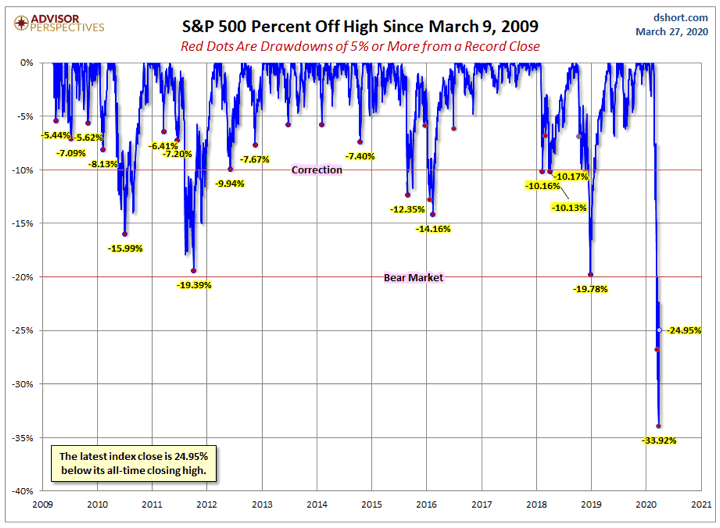Updated 2020. How many e-mails have you gotten regarding “recent market volatility”? The advice is almost always the same, think long-term. Feeling some fear and uncertainty is normal. During extreme times, a phrase often heard will be “I’m just going to take some money off the table until things calm down. Why risk it?”
What happens when you play it safe? Here’s a 2015 chart from FiveThirtyEight.com comparing the results of a “cautious, play-it-safe” investor and the “do-nothing” investor:

Imagine two people who each invested $1,000 in the S&P 500 at the beginning of 1980. The first one buys once and never sells. The second one is slightly more cautious: He sells any time the market loses 5 percent in a week, and buys back in once it rebounds 3 percent from wherever it bottoms out. At the end of last week, the first investor’s holdings would be worth $18,635. The second investor would have just $10,613.
This is interesting, because they let you (sort of) pick the temporary bottom. But as you can see, you miss the huge gains. Perhaps the key is that you waited to sell until the market dropped first. If you wait until that sharp drop, then it’s probably already too late.
Remember, the only two possibilities for the stock market are all-time high or a drawdown. The highs you don’t really feel. The drawdowns are quite painful. Here’s a continuously updated chart from Doug Short illustrating the drawdowns since 2009. Lots of painful drawdowns, but during that time the market is up over 200%.

This is also why financial advisors tell you to create an investment policy statement. That’s where you write down ahead of time “If [this] happens to my portfolio, I will do [action or lack of action] because [reason].” Then when the drop actually happens, you break out that piece of paper to remind yourself what the calm, rational version of yourself would have done.
I would also add that this is why I don’t support the “100% in stocks” argument that I hear 10X more often after a long bull market. With time and pain, I have come to appreciate the warm fuzzies that come from owning a nice chunk of safe, liquid bonds.
 The Best Credit Card Bonus Offers – November 2024
The Best Credit Card Bonus Offers – November 2024 Big List of Free Stocks from Brokerage Apps
Big List of Free Stocks from Brokerage Apps Best Interest Rates on Cash - November 2024
Best Interest Rates on Cash - November 2024 Free Credit Scores x 3 + Free Credit Monitoring
Free Credit Scores x 3 + Free Credit Monitoring Best No Fee 0% APR Balance Transfer Offers
Best No Fee 0% APR Balance Transfer Offers Little-Known Cellular Data Plans That Can Save Big Money
Little-Known Cellular Data Plans That Can Save Big Money How To Haggle Your Cable or Direct TV Bill
How To Haggle Your Cable or Direct TV Bill Big List of Free Consumer Data Reports (Credit, Rent, Work)
Big List of Free Consumer Data Reports (Credit, Rent, Work)
Speak Your Mind